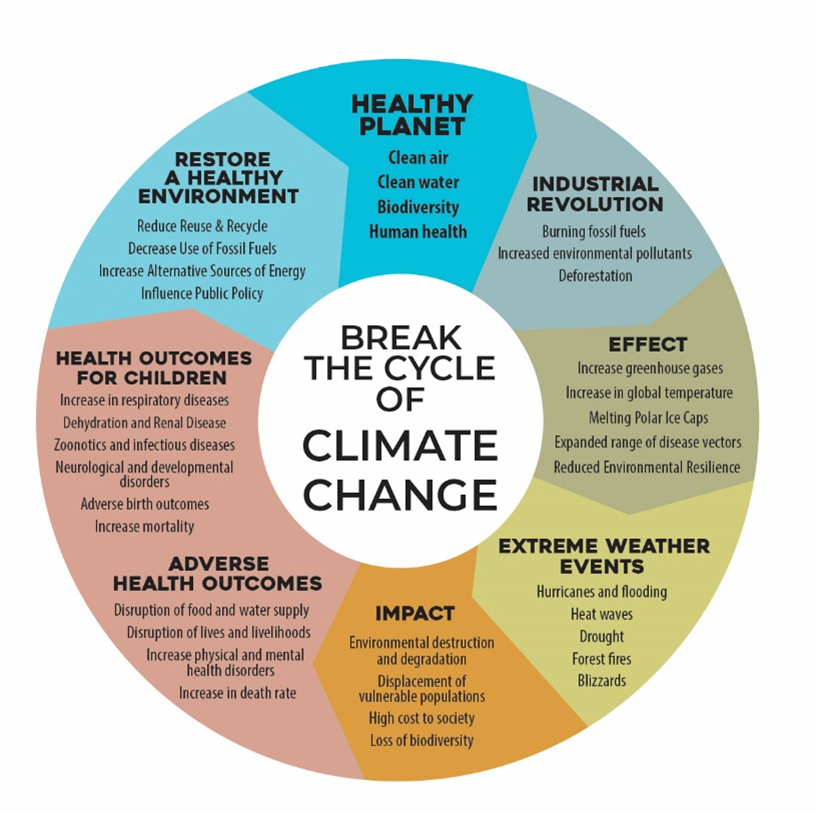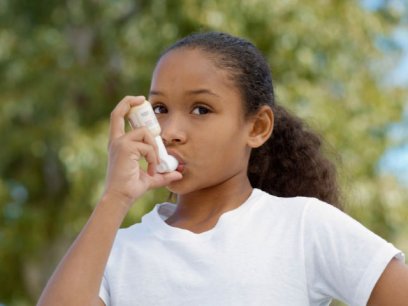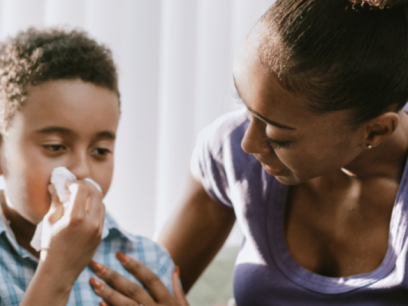
Good health starts with a clean environment. Environmental health is the science and practice of preventing human injury and illness and promoting well-being by identifying, evaluating, and limiting exposure to hazardous agents in the air, water, soil, and food.
Chemical pollution, air pollution, poor water quality, and lack of access to healthcare are key environmental factors affecting health. Children and infants are at higher risk of being impacted by pollution or other environmental factors.

Today, health concerns for children, such as asthma, obesity and complications of hypertension and diabetes, and neurodevelopmental disorders are often caused or exacerbated by environmental factors. Children who grow up with social and economic disadvantages are at greater risk for exposure to harmful environmental factors and are more likely to suffer from adverse health and developmental conditions.
Breaking the Cycle of Inequality in Environmental Health
The EPA defines environmental justice as the fair treatment and meaningful involvement of all people regardless of race, color, national origin, or income to make sure everyone has the opportunity to live the healthiest life possible.
Break the Cycle of Health Disparities, Inc. is a non-profit organization launched in 2005 that brings together environmental health experts working to advance environmental justice. Each year, the organization partners with Emory University to host the “Break the Cycle of Children’s Environmental Health Disparities” conference. The 17th annual Break the Cycle (BTC) Conference was held virtually on April 18-19, 2022.
“Today, as a society, we are much more aware of the social, economic, racial, and environmental determinants of health disparities, exacerbated by the COVID-19 pandemic and by the impact of climate change,” said Break the Cycle founder Dr. I. Leslie Rubin.
This year’s conference focused on climate change’s disproportionate impact on children facing socio-economic challenges.

The focus on climate change helps to raise awareness of the adverse health impacts of climate change on children, especially poor children and children of color. The topic is relatively new for most medical professionals and is not typically included as part of a doctor’s formal education or residency training.
Children’s Environmental Health Research in Action
As part of its educational programming, the Break the Cycle training program supports student-driven research projects exploring the social, economic, and environmental factors that adversely affect children’s health and well-being, with the goal of developing creative strategies that promote well-being and health equity for all children. The collaborative program cultivates future leaders among university students both nationally and internationally.
One of these leaders is Dr. Shalini Shah, a practicing pediatrician and current Environmental Health Fellow at Boston Children’s Hospital. She presented her project titled “The More You Know – Insights from Integrated Pre-Visit Surveys in a Pediatric Environmental Health Center” at the 2022 BTC Conference.
Shah developed an online environmental health screening tool for use in clinical settings to raise awareness of environmental exposures, support families with educational resources, and increase referrals to community-based programs.
“Our goal is to help providers go into their visit really informed about what will be most helpful for a patient and their family,” said Shah.
The online tool screens for a variety of exposures, including lead, mold, air quality, and temperature. Real-time education is embedded for patients as they complete the survey. A broader version of the survey is expected to soon be rolled out for use throughout the hospital, for both general pediatric patients as well as specific sub-populations.
This new resource will help patients and healthcare providers be aware of environmental factors that might be impacting asthma, a common, chronic childhood disease that disproportionately impacts Black, Hispanic, and socioeconomically disadvantaged communities.
Asthma is directly linked to environmental triggers. Our project is working to break the cycle of inequity since we know that incidents of asthma are disproportionate and based on systemic and racial inequity.
Dr. Shalini Shah, Pediatrician, Boston Children’s Hospital
How Climate Change Affects Public Health
The World Health Organization explains that climate change threatens the social and environmental foundations of good health:
- Clean air
- Safe drinking water
- Sufficient food
- Secure shelter
Break the Cycle’s focus on the intersection of climate change and children’s health puts a timely focus on an issue that Rubin and Shah are passionate about.
“Climate change is a real threat to children’s health, particularly for children from poor and marginalized communities of color,” said Rubin.
These problems are already happening, whether we realize it or not. That’s why it’s vital to expand public health education about environmental exposure due to climate change to help communities become more resilient.
“It’s important that healthcare providers have an answer for patients who want to know how climate change is impacting their health,” said Shah.
In the Northeast, where Shah is based, current impacts from climate change include dehydration due to extreme heat, disruptions in healthcare availability due to natural disasters, lower air quality from wildfire smoke, and mental health challenges.
“Climate change is another filter to add to our overall approach to standardized medicine. Health equity and environmental justice should be part of the core curriculum, integrated into existing frameworks,” said Shah.
Learn More About Pediatric Asthma and Environmental Health
“Break the Cycle’s work to raise awareness of environmental health disparities helps inspire, motivate, and mobilize young people to be creative in developing projects that promote health equity for all children,” said Rubin.
Learn more about Break the Cycle and children’s environmental health from these resources.
- NEEF’s Pediatric Asthma Initiative: Review more information about asthma care and management for medical and public health professionals, including a free eLearning course developed to help pediatric healthcare providers and clinicians manage environmental asthma triggers and intervention strategies.
- Pediatric Environmental Health Specialty Units (PEHSU): Shah recommends visiting the PEHSU Region 1 website for a variety of resources related to reproductive and children’s environmental health, including tools she used while developing the survey at Boston Children’s Hospital. PEHSUs are academically based, typically at university medical centers, and are located across the United States, Canada, and Mexico. The annual BTC Conference is a partnership between Break the Cycle and the Region 4 PEHSU at Emory University.


